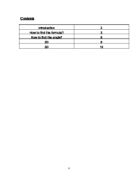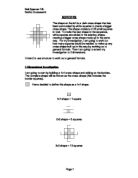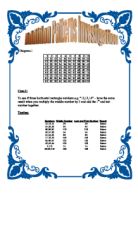Investigation to Find the number of diagonal of any 2 Dimensional or / and 3 Dimensional - A diagonal is a line drawn from one vertex (corner) of the shape to another
Contents
Introduction
2
How to find the formula?
3
How to find the angle?
8
2D
9
3D
2
Introduction
I will start my course-work by explaining off what the task is that I'm going to do. I have to find the number of diagonal of any 2Dimensional or/and 3Dimensional. A diagonal is a line drawn from one vertex (corner) of the shape to another, which is not an edge of the shape. Then, I will write some short sentences describing the task along with the diagram, which will be useful, including what I hope to find.
To solve this problem, I will explain what I am going to do by starting with simple cases. For example, Triangle then Square then Pentagon and so on. What I think will happen and show all my calculation.
In order to show the patterns, I could draw graphs to show it, including the results in the table. I must describe all the patterns and rules I find, explain each one clearly and show that my rules work by doing another examples of it.
If I find the rules or the pattern, I will try explaining why they work. For example, If I discover that a number patterns goes up in 4s, my task may involve as 4-sided shape that causes this.
In this experiment I am going to require the following:
A calculator
A pencil
A pen
Variety of sources of information
Paper
Ruler
In this investigation I have been asked to find out how many squares
would be needed to make up a certain pattern according to its sequence.
The pattern is shown on the front page. In this investigation I
hope to find a formula which could be used to find out the number
of squares needed to build the pattern at any sequential position.
Firstly I will break the problem down into simple steps to begin
with and go into more detail to explain my solutions. I will illustrate
fully any methods I should use and explain how I applied them to
this certain problem. I will firstly carry out this experiment on
a 2D pattern and then extend my investigation to 3D.
How to find the formula?
Finding and verifying a formula for the nth term of a sequence is the "icing on the cake" of a course-work. We shall give some examples of how to go about it.
If the numbers in the sequence increase in EQUAL STEPS then things are fairly straightforward. For example:
5 , 8 , 11 , 14 , 17 , ... (step length 3)
26 , 31 , 36 , 41 , 46 , ...(step length 5)
20 , 18 , 16 , 14 , 12 , ...(step length -2)
Let's do the first of these examples.
First, we'll draw up a table, giving each term its "counter" (generally called n):
n
2
3
4
5
. . .
Term
5
8
1
4
7
. . .
The common step length is 3. So the formula will be
3×n + something
This is because, if the step length is the same for all the terms in the sequence, the formula will be of the format
step ...
This is a preview of the whole essay
Let's do the first of these examples.
First, we'll draw up a table, giving each term its "counter" (generally called n):
n
2
3
4
5
. . .
Term
5
8
1
4
7
. . .
The common step length is 3. So the formula will be
3×n + something
This is because, if the step length is the same for all the terms in the sequence, the formula will be of the format
step × n + something
For the sequence above, the rule 3×n + something would give the values
3×1 + something = 3 + something
3×2 + something = 6 + something
3×3 + something = 9 + something
3×4 + something = 12 + something
3×5 + something = 15 + something
Compare these values with the ones in the actual sequence - it should be obvious that the value of the something is +2
So the formula for the nth term is 3n + 2
Now let's do the second example....
n
2
3
4
5
. . .
Term
26
31
36
41
46
. . .
The common step length is 5. So the formula will be
5×n + something
For the sequence above, the rule 5×n + something would give the values
5×1 + something = 5 + something
5×2 + something = 10 + something
5×3 + something = 15 + something
5×4 + something = 20 + something
5×5 + something = 25 + something
Compare these values with the ones in the actual sequence - it should be obvious that the value of the something is +21
So the formula for the nth term is 5n + 21
Now let's do the third example....
n
2
3
4
5
. . .
Term
20
8
6
4
2
. . .
The common step length is -2. So the formula will be
-2×n + something
For the sequence above, the rule -2×n + something would give the values
-2×1 + something = -2 + something
-2×2 + something = -4 + something
-2×3 + something = -6 + something
-2×4 + something = -8 + something
-2×5 + something = -10 + something
Compare these values with the ones in the actual sequence - it should be obvious that the value of the something is +22
So the formula for the nth term is -2n + 22 or written more neatly 22 - 2n
If the terms do NOT increase in equal steps, then I have to think about things a bit more. Here is an example:
4, 7, 12, 19, 28, steps are +3, +5, +7, +9
If the steps between the terms are not equal, try a rule based on
n2 + something
n
2
3
4
5
. . .
Term
4
7
2
9
28
. . .
For the sequence above, the rule n2 + something would give the values
2 + something = 1 + something
22 + something = 4 + something
32 + something = 9 + something
42 + something = 16 + something
52 + something = 25 + something
Compare these values with the ones in the actual sequence - it should be obvious that the value of the something is +3
So the formula for the nth term is n2 + 3
Now, let's move to more complicated once ...
The key to finding a formula for the nth term of a sequence is to consider the differences (or "step lengths") between the terms.
If the first differences are same, then the formula will be a linear function of the form a×n + b where a and b are numbers which I have to work out.
If the first differences are not same, but the second differences are same, then the formula will be a quadratic function of the form a×n2 + b×n + c where a, b and c are numbers which I have to work out.
For the sequence I have, we find that the first differences are not same but the second differences are same:
This means that we should look for a quadratic formula a×n2 + b×n + c
We now have to work out the values of the coefficients a, b and c.
For the first term, n=1. Substituting n=1 into the formula gives
a×12 + b×1 + c = 22
This simplifies to
a + b + c = 22
For the second term, n=2. Substituting n=2 into the formula gives
a×22 + b×2 + c = 34
This simplifies to
4a + 2b + c = 34
For the third term, n=3. Substituting n=3 into the formula gives
a×32 + b×3 + c = 49
This simplifies to
9a + 3b + c = 49
This gives us a set of three simultaneous equations in three unknowns:
a + b + c = 22 -------(1)
4a + 2b + c = 34 -------(2)
9a + 3b + c = 49 -------(3)
Solving three simultaneous equations is usually quite tricky, but here the equations are not too bad. Notice that they each have single "+ c"at the end. We will first eliminate c to reduce this to two simultaneous equations just in a and b.
Subtract (1) from (2) column-by-column:
3a + b = 12 -------(4)
Subtract (1) from (3) column-by-column:
8a + 2b = 27 -------(5)
If I have got this far, I should be happy with solving two simultaneous equations (we hope!).
a = 1.5, b = 7.5
Finally replace a and b in the very first equation (1) to find c:
.5 + 7.5 + c = 22 which means c = 13
So the formula for the nth term of the sequence is:
.5×n2 + 7.5×n + 13
It would be wise to check this. Replacing n=4 we do to be positive to find that the fourth term of the sequence works out to be 67, as it should:
.5×42 + 7.5×4 + 13 = 24 + 30 + 13 = 67
How to find the angle?
There are 2 way's in finding the angle:
Interior Exterior
As you can see that the Octagon is divided into 6 triangles. The first method in to finding the angle is by finding the exterior angle.
Let me give you an example:
As you know that the exterior angle adds up to 3600
> 360 divide by the number of angles
> 360 / 8 = 45
> 180 - 45 = 135
The second method in to finding the angle is by interior angle.
Number of triangle x 180
6 x 180 = 1080
080 divided by the number of angles
080 / 8 = 135
2D
This shape does not have any diagonal, because, as you know that the diagonal can only be from corner to corner.
This shape has only 2 diagonal. Because, as you know that the diagonal can only be from corner to corner.
This shape has 5 diagonal. Because, as you know that the diagonal can only be from corner to corner.
Number of sides(s)
Differences
Diagonal (d)
3
3
0
4
2
2
5
0
5
6
3
9
7
7
4
8
2
20
9
6
27
0
25
35
1
33
44
2
42
54
3
52
65
4
63
77
5
75
90
6
88
04
7
02
19
8
17
35
9
33
52
20
50
70
The table above shows the number of sides (s) and the diagonal (d). If the number in the (s) column goes up one at a time, look at the (d) column. If it goes up (or down) by the same number each time, the function connecting (d) and (s) is linear. This means that there are no terms in (s)2 or anything more complicated.
The formula for 2Dimensional shape is (n/2) - 1.5 x n
--> (n/2) - 1.5 x n --> (n/2) - 1.5 x n --> (n/2) -1.5 x n
--> (4/2) - 1.5 x 4 --> (3/2) - 1.5 x 3 --> (6/2) - 1.5 x 6
--> 2 - 1.5 x 4 --> 1.5 - 1.5 x 3 --> 3 - 1.5 x 6
--> 0.5 x 4 --> 0 x 3 --> 1.5 x 6
--> 2 --> 0 --> 9
3D
This shape has 2 diagonal, as you know that, the triangles do not have any diagonal.
This shape has 16 diagonal, including the inside.
This shape has 30 diagonal; this is because a pentagon has a diagonal of 5. This shape has 2 pentagons, which means 5 x 2, which brings us to 10. That's why you get more diagonal than 2Dimensional shape.
Number of sides (s)
Differences
Diagonal
3
3
6
4
2
6
5
25
30
6
42
48
7
63
70
8
88
96
9
17
26
0
50
60
1
87
98
2
228
240
3
273
286
4
322
336
5
375
390
6
432
448
7
493
510
8
558
576
9
627
646
20
700
720
I've now constructed a table with the number of sides (s), differences and the diagonal (d). For this, we should look for a quadratic formula a×n2 + b×n + c, we should look at this formula because as you know the sequence I've done, we find that the first differences are not same but the second differences are same:
For example:
The formula for 3-d shape is
Let me give you a few examples
My Conclusions
I have made a number of conclusions from the investigation I have carried out.
Firstly I have deciphered that the equation used in the 2D pattern
Was a quadratic. This can be proven through the fact that the 2nd
Difference was a constant, a necessary element of any quadratic
And also the fact that the first value has to be squared. This can
Also be proved by illustrating the equation on the graph, creating a curve.
I have also established that the top triangular half of the 2D pattern
Always turns out to be a square number.
If we now look at the 3D pattern, the equation I achieved for it
Has turned out to a cubic equation. This can be proven through the
Constant, again a necessary characteristic of any cubic equation
And also the fact that its 1st value must be cubed and it's second
Squared. If we drew a graph we would get a curved graph in which
The line falls steeply, levels off and then falls again.
The Differentiation Method developed by Jean Holderness played a
Very important role in this investigation. It helped us to gain
Knowledge of any pattern and anything that would help in the investigation,
Giving us our constant, but most importantly it gave us the equation
On which to base our solutions.
It was:
An<sup>2</sup> + bn + c
This proved very helpful.
To find our equation we then substituted in different values which
We could find in our differentiation table.
I have concluded that both the equations proved to be very successful.
Therefore the equations are:
For the 2D pattern the equation is;
2n<sup>2</sup> - 2n + 1
For the 3D pattern the equation is;







